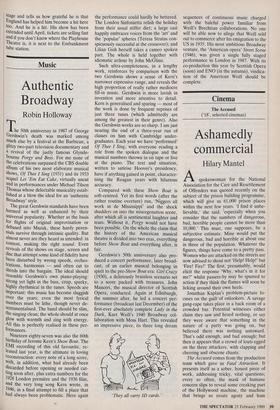Music
Authentic Broadway
Robin Holloway
The 50th anniversay in 1987 of George Gershwin's death was marked among much else by a festival at the Barbican, a glitzy two-part television documentary and a revival of the justly famous Glynde- bourne Porgy and Bess. For me none of the celebrations surpassed the CBS double album of his two most elaborate musical shows, Of Thee I Sing (1931) and its 1933 sequel Let 'Em Eat Cake, virtually uncut and in performances under Michael Tilson Thomas whose delectable musicality estab- lished at a blow the ideal for an 'authentic Broadway' style.
The great Gershwin standards have been harmed as well as enhanced by their universal popularity. Whether as the basis for flights of original improvisation or debased into Muzak, these hardy peren- nials survive through intrinsic quality. But almost never are they heard as intended: in context, making the right sound. Even revivals of the shows on stage, screen and disc that attempt some kind of fidelity have been disturbed by wrong speeds, orches- trations, harmonies — and often cut to shreds into the bargain. The ideal should resemble Gershwin's own piano-playing: strong yet light in the bass, crisp, sparky, hi. ghly rhythmical in the tunes. Speeds are important: this music has become sluggish over the years; even the most lyrical numbers must be lithe, though never de- sentimentalised. The band should be slim, the singing clean; the whole should at once glow with warmth and zing with energy. All this is perfectly realised in these per- formances.
Nineteen eighty-seven was also the 60th birthday of Jerome Kern's Show Boat. The EMI recording of this old favourite, re- leased last year, is the ultimate in loving reconstruction: every note of a long score, With, in addition, what had already been discarded before opening or needed cut- ting soon after, plus extra numbers for the 1928 London premiere and the 1936 film, and the very long song Kern wrote, in 1946, in a final attempt to fill a place that had always been problematic. Here again the performance could hardly be bettered. The London Sinfonietta relish the holiday from their usual stiffer diet; a large cast happily embraces voices from the `art' and the `popular' spheres (Teresa Stratas con- spicuously successful at the crossover); and Lilian Gish herself takes a cameo spoken part. The whole is held together with idiomatic ardour by John McGlinn.
Such ultra-completeness, in a lengthy work, reinforces by comparison with the two Gershwin shows a sense of Kern's narrower expressive range, and reveals the high proportion of really rather mediocre fill-in music. Gershwin is more lavish in invention and more attentive to detail. Kern is generalised and sparing — most of the work is done by frequent reprises of just three tunes (which admittedly are among the greatest in their genre). Also the Gershwin works are so sharp. I am just nearing the end of a three-year run of classes on him with Cambridge under- graduates. Each year we have 'performed' Of Thee I Sing, with everyone reading a role from the spoken dialogue and the musical numbers thrown in on tape or live at the piano. The text and situation, written to satirise Hoover's presidency, have if anything gained in point, character- ising the Reagan years with hilarious accuracy.
Compared with these Show Boat is soft-centred. Yet its first words (after the rather routine overture) run, `Niggers all work in de Mississippi' and the shock shudders on into the miscegenation scene, after which all is sentimental laughter and tears. Without it, Porgy would not have been possible. On the whole the claim that the history of the American musical theatre is divided into two eras, everything before Show Boat and everything after, is fair.
Gershwin's 50th anniversary also pro- duced a concert performance, later broad- cast, of an earlier musical belonging in spirit to. the pre-Show Boat era: Girl Crazy (1930), a deliriously brainless scenario set to a score packed with treasures. John Mauceri, the musical director of Scottish Opera, conducted. Again at Edinburgh, the summer after, he led a concert per- formance (broadcast last December) of the first-ever absolutely complete Lady in the Dark, Kurt Weill's 1940 Broadway col- laboration with Moss Hart. This revealed an impressive piece, its three long dream `They all carry ID cards.' sequences of continuous music charged with the baleful power familiar from Weill's Brechtian collaborations. No one will be able now to allege that Weill sold out to commerce after his emigration to the US in 1935. His most ambitious Broadway venture, the 'American opera' Street Scene (1946), was given a single fully staged performance in London in 1987. With its co-production this year by Scottish Opera (soon) and ENO (in the autumn), vindica- tion of the American Weill should be complete.
















































 Previous page
Previous page